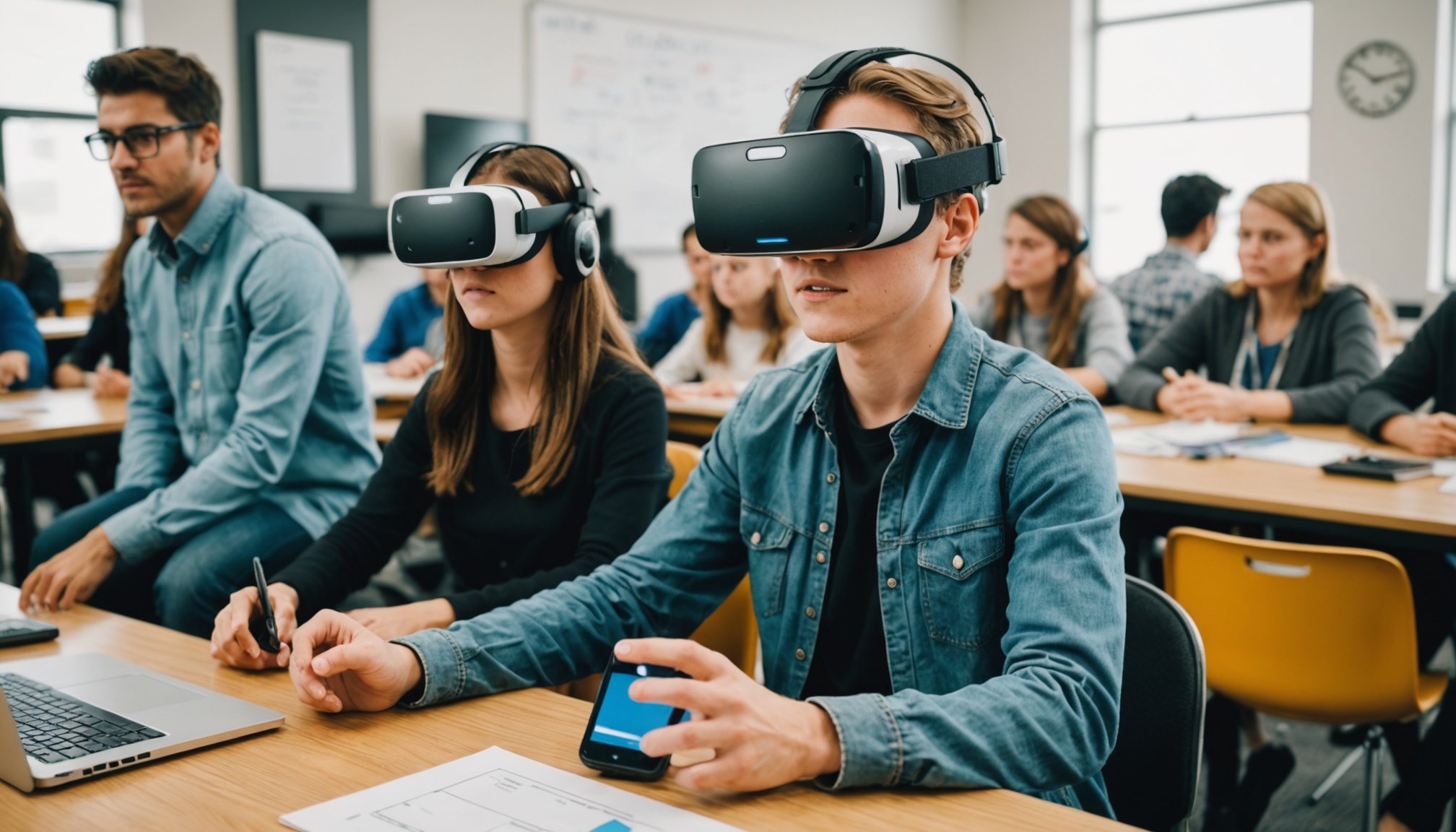Overview of Virtual Reality in Education
Virtual reality education is revolutionising how learning is perceived, offering an immersive learning experience pivotal for modern educational technology. By simulating real-world environments, students can comprehend complex subjects more effectively, allowing them to interact directly with content within an expanded educational landscape.
Historically, virtual reality began as a tool for military and aviation training, providing safe environments for practising high-stakes scenarios. Its evolution has expanded its scope to include diverse educational fields, capitalising on technological advancements to make educational technology accessible and practical for real-world learning. This innovation provides an unparalleled platform for experiential learning.
Also to discover : Transforming public infrastructure: the impact of iot technology on monitoring and maintenance solutions
Current trends show that virtual reality education is gaining significant traction globally. Schools and universities increasingly incorporate VR into their curriculums. Recent statistics reflect this growth, revealing a consistent rise in the adoption of immersive learning tools across educational institutions. This development underscores the transformative impact of VR in modern education systems, signalling a shift towards more holistic and interactive learning approaches. As VR technology continues to advance, its role in educational technology is poised to expand, promising even greater integration and impact in the educational sector.
Benefits of VR in Educational Settings
Virtual reality education offers a myriad of benefits, particularly in enhancing student engagement and motivation. By immersing students in vivid, interactive experiences, VR enables learners to connect more deeply with the material. This heightened engagement promotes active participation, which is crucial for more effective learning.
Additional reading : Transforming industrial automation: essential innovations in sensor technology you must explore
Immersive experiences are known to significantly impact knowledge retention. When students engage with content interactively, such as through VR simulations or virtual field trips, they are more likely to recall and apply what they’ve learned. This hands-on approach not only supports memory retention but also aids in developing practical skills.
One of the standout advantages of VR is its ability to provide customizable learning opportunities tailored to diverse learning styles. Students who benefit from visual or kinesthetic learning can particularly thrive in a VR-enhanced environment. Interactive modules allow educators to adapt the learning experience to suit individual needs, thereby fostering a more inclusive educational setting.
Through VR, students are afforded the chance to explore topics in a manner that traditional methods may not allow, reinforcing the value of interactive learning in modern education. These experiences nurture curiosity, creativity, and a deeper understanding of complex subjects.
Key Applications of VR in Education
Virtual reality (VR) is transforming the educational landscape through its diverse applications, particularly in fostering experiential learning and enhancing educational simulations. This section will explore its profound impact across varying educational levels and specialised fields.
In the realm of K-12 and higher education, numerous case studies highlight how VR has successfully been incorporated into learning. For example, history students might “walk” through ancient cities, while biology classes can explore cellular structures in 3D. This hands-on interaction significantly deepens understanding and retention of the subject matter.
Furthermore, VR’s utility shines in specialised fields like medicine and engineering. In medical education, simulations enable students to practise surgical procedures in a risk-free environment, significantly boosting their skills before real-world application. Engineering students can virtually construct and test models, thereby comprehending intricate concepts with higher precision.
Educational simulations within VR are especially effective, as they mimic real-world scenarios, offering students a chance to apply their knowledge in controlled settings. These applications of VR not only make learning enjoyable but also empower students with invaluable practical experience, ultimately leading to improved educational outcomes.
Technologies Driving VR in Education
Leveraging VR technology in education relies heavily on selecting the right immersive tools and educational platforms. Popular VR platforms such as Oculus Rift, HTC Vive, and Google Cardboard offer varied experiences, from high-end immersive experiences to more affordable options. Educators need to balance these choices based on classroom resources and desired educational outcomes.
When evaluating VR hardware and software, considerations include device compatibility, ease of use, and content availability. High-performance systems like the Oculus Rift provide superior immersive experiences but come at a higher cost. In contrast, platforms like Google Cardboard offer more accessible solutions, making VR experiences affordable and attainable for more classrooms.
Future technologies hold the promise of expanding the reach and scope of educational VR experiences. Advancements like augmented reality integration, haptic feedback, and AI-driven content could further enhance the interactive learning environment. These innovations are anticipated to drive more profound integration of VR in education, offering even more dynamic and enriching experiences.
Educators and institutions interested in adopting VR must remain informed about these technologies to ensure effective and seamless implementation. By understanding the available options, they can make informed decisions that best fit their educational needs.
Expert Insights on VR in Education
Education experts emphasise the transformative impact of virtual reality (VR) on learning outcomes, with research consistently highlighting enhanced student engagement and knowledge retention. Educators and researchers are increasingly examining VR’s role in fostering critical thinking and problem-solving skills. Studies have shown students immersed in VR environments demonstrate improved comprehension of complex subjects, as they benefit from experiential and interactive learning.
Renowned experts advocate for incorporating VR into diverse educational contexts, underlining its potential to cater to various learning styles. Education experts recommend integrating VR effectively by aligning it with curriculum objectives and ensuring that VR tools supplement rather than overshadow traditional teaching methods. Their insights suggest prioritizing VR applications that offer measurable learning benefits, ensuring a direct contribution to student achievement.
Professional opinions also stress the importance of continuous evaluation of VR methods, advocating for a data-driven approach to assess effectiveness. By analysing VR research outcomes, educators can refine strategies, enhancing teaching impacts. Ultimately, the push from the academic community is towards a more holistic adoption of VR, ensuring its sustained relevance and efficacy in modern education systems.
Challenges and Considerations for VR Implementation
The integration of virtual reality (VR) in education offers substantial benefits, but it also poses significant implementation challenges. Chief among these is the cost of VR, which can be prohibitive for many educational institutions. Advanced VR systems require substantial investment not only in hardware but also in software and maintenance. Schools must weigh these expenses against the potential educational gains.
Accessibility and inclusivity concerns further complicate the implementation of VR technology. Ensuring that all students, regardless of physical or cognitive abilities, can participate in VR-enhanced learning is crucial. Institutions need to consider adaptive technologies and platform inclusivity to cater to diverse learner needs.
Furthermore, the budget considerations and potential return on investment (ROI) for educational VR programs play a pivotal role in decision-making. While the upfront costs are steep, calculated adoption, targeting areas with the highest impact, can justify the investment. Schools should explore opportunities for grants, partnerships, and funding to alleviate financial burdens.
Navigating these challenges requires careful planning and resource allocation. Successful VR implementation considers both financial and ethical dimensions, ensuring broader student access to technology-driven learning advancements.
Practical Tips for Integrating VR into Learning Environments
Integrating VR technology effectively into educational settings requires thoughtful approaches and adequate resources. Educators looking to embrace VR in their classrooms can follow practical steps to ensure successful implementation. Initially, start by choosing student-friendly VR platforms that align with curriculum goals. Oculus Rift or Google Cardboard are great starting points, depending on budget and educational objectives.
Further, invest time in exploring available educator resources, both online and through professional learning communities. These resources provide insights into best practices and innovative lesson plans. Engaging with VR-focused forums and workshops can enhance understanding, offering helpful guidance and inspirational ideas.
When crafting lesson plans with VR integration, consider the specific learning outcomes you wish to achieve. Aim for a balanced blend of traditional teaching methods and immersive VR tools to foster a rich learning experience. Tailoring content to accommodate various learning styles will promote inclusivity.
Finally, encourage a classroom atmosphere that embraces innovation and experimentation. Facilitate discussions that explore the experiences and insights gained through VR activities. By adopting these strategies, educators can smoothly transition into VR-enhanced learning, optimising student engagement and achievement.







